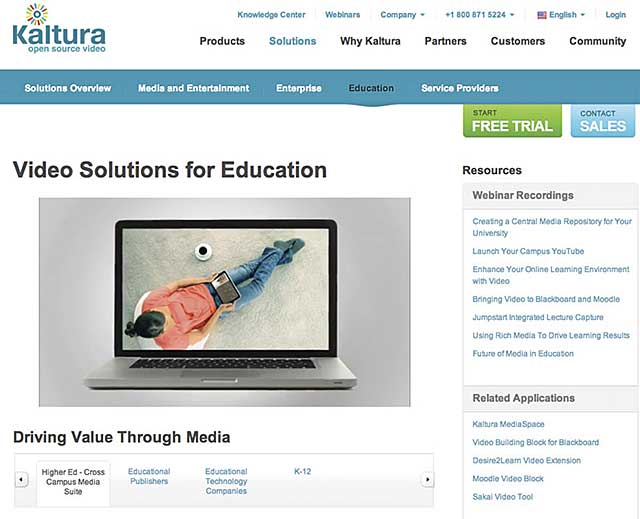The State of the Streaming Industry 2013
The net loss attributable to common stockholders narrowed considerably to $13.9 million, compared to $23.3 million for 2011. The depletion of cash was a very reasonable $7.5 million, which was mainly attributable to the Zencoder purchase.
For 2013, the company is predicting an increase in revenue to just over $100 million, but this will still mean a loss of $4.5 million to $6.5 million in 2013. Based on those numbers, Brightcove won't achieve profitability until 2014 at the earliest.
Kaltura Looks to Grow in Asia, Education
Like Ooyala, Kaltura, Inc., was also in the market for more investment and raised $25 million to further fuel its expansion. Part of this funding was earmarked for growth in the Asia-Pacific region to try to put itself on a more even footing with Ooyala's existing expansion plans. In addition, Kaltura wanted to use its base in education as a springboard for its products to continue expanding into media and corporate environments.
"What fuels the company's hyper growth is our flexible platform, which enables us to launch integrated products that transcend us beyond the traditional online video platform space into other large industries such as Education Technology and Enterprise Collaboration," said Ron Yekutiel, Kaltura chairman and CEO. "We intend to use this new funding to expand our product offering, and to grow into additional industries and geographies."

Due in part to its open source roots, Kaltura has gained a foothold in the education market. It plans to use part of its recent $25 million investment to continue to grow its presence there.
Kaltura spent 2012 looking at Europe as an area of focus. It already had a substantial lead in North America in terms of users (if not necessarily in terms of revenue) due to its open source nature. Major wins in Europe in 2012 included Arup, IKEA, and Groupon, and there was a significant increase in staff across Europe in the year.
Whether Kaltura can take on Ooyala in the Asia-Pacific region is likely to be one of the more interesting developments to follow in 2013.
Social Media and YouTube at the Fore
All the OVPs have at least one eye on social media as platforms for further expansion as was made clear by the Ooyala Twitter cards development. It should of course be noted that one of the biggest streaming successes of the year was based on corporate sponsorship.
Felix Baumgartner's record-breaking, faster-than-sound descent proved a big hit for YouTube with 8 million concurrent viewers. It should also be remembered that this entire project was brought about by corporate sponsorship, as it was Red Bull's Stratos project.
The integration of the campaign into both social media to drive traffic to the often delayed event and streaming via YouTube itself should be noted for a number of reasons. First as the jump was pushed back by 4 days, social media was essential in delivering the audience to the stream and ensuring that it was kept top of mind throughout the delay in its audience's mind.
Second, the project marked the point where YouTube became a highly robust corporate platform for the right kind of media. Handling 8 million concurrent viewers flawlessly is not a task to be taken lightly.
Finally, this was a great example of how this type and quality of social media-driven streaming has changed over the last year. This is not a one-off but the start of a new approach. Throughout 2012, whether the webcast was streamed via YouTube, Facebook, or Google+, the level of sophistication of corporate streaming has jumped immeasurably.
This encompasses the methods that are used to get a return from the webcast. Many examples look to use a mixture of models including advertising, sponsorship, webcast-related sales, and simple audience building such as gaining likes on a Facebook page. By employing a mixture of methods, many of these broadcasts not only generate revenue but rapidly build audiences for regular programming.
There has also been a significant leap forward in the quality and sophistication of the live programmes themselves. A wide range of formats have emerged from simple interactive Q&As to heavily produced magazine programmes to highly interactive product showcases to discussions between major stars and their fans leveraging Google+ and YouTube.
These social media platforms have, throughout the year, given many consumer-facing corporations significant returns on their webcasting. It will be interesting to see how costs decrease and potential audiences increase B2B corporations looking to exploit the medium.
This continual growth of the worldwide audience along with the spread of more standardised ways through the OVPs and other platforms to deliver to a wide range of devices looks likely to sustain the growth in audiences over the last 12 months. The interesting question for the next year is how these audiences will find the content, which platforms will help to deliver it, and how the businesses will evolve the medium and the associated business models.
This article appears in the 2013 Streaming Media Europe Industry Sourcebook.